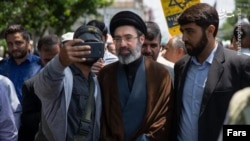Welcome back to The Farda Briefing, an RFE/RL newsletter that tracks the key issues in Iran and explains why they matter.
I'm RFE/RL correspondent Golnaz Esfandiari. Here's what I’ve been following during the past week and what I’m watching for in the days ahead.
The Big Issue
Iran’s Rasa news agency has rekindled rumors that Mojtaba Khamenei, the influential son of Supreme Leader Ayatollah Ali Khamenei, is being groomed as the successor to his elderly father, despite his lack of credentials.
Affiliated with seminaries in the holy Shi’ite city of Qom, the agency used the title of ayatollah to refer to Mojtaba Khamenei. The move has fueled speculation that the younger Khamenei is being promoted ahead of possibly succeeding his 83-year-old father, who underwent prostrate surgery in 2014 amid rumors about his health.
Ayatollah is an honorific title reserved only for high-ranking clerics. Mojtaba Khamenei had previously been referred to as a hojatoleslam, a title that refers to mid-ranking clerics.
Why It Matters: Rasa’s reference to the young Khamenei as an ayatollah comes after a statement last month by opposition figure Mir Hossein Musavi, who warned that the leadership in Iran could become “hereditary.”
“The news of this conspiracy has been heard for 13 years. If they’re not looking into it, why have they not once denied such an intention?” asked Musavi, who has been under house arrest since 2011.
Rumors about Mojtaba Khamenei as a possible successor to his father first emerged during mass anti-government protests following the disputed presidential election in 2009. He became a target of chants by opposition activists during the rallies, with some chanting: "Mojtaba, may you die and not become the supreme leader!" He was rumored to have been involved in the brutal crackdown on protesters that year.
What’s Next: With officials refusing to comment, speculation is likely to grow around the younger Khamenei. Iran’s hard-line President Ebrahim Raisi, a Khamenei protege, has also been rumored as a potential successor.
Speculation over Khamenei’s successor is likely to mount due to his age and rumors about his health. The Assembly of Experts, an 88-member chamber of theologians, all male, picks and nominally oversees the work of the country's supreme leader. But it is unclear exactly what actual role the assembly is likely to play in choosing Iran's third supreme leader.
Stories You Might Have Missed
• Iranian women were allowed to attend a national soccer match for the first time in decades. The dozens of women used the occasion on August 25 to pay tribute to a fan who set herself on fire to protest the authorities' ban on female spectators.
Sahar Khodayari self-immolated in September 2019 outside a courthouse where she had been summoned after being arrested for trying to enter Azadi Stadium dressed as a man. Her death caused outrage, intensifying pressure on the authorities to allow women into soccer stadiums. Since the incident, women have been permitted to attend several matches.
• Iranian officials have dragged their feet for over a year in indirect negotiations with the United States to revive the 2015 nuclear deal. During that time, Tehran has told Iranians that the country can survive without a nuclear agreement.
But the rhetoric has changed in recent weeks as Iran and the United States are on the cusp of agreeing to restore the deal. Observers say Iranian officials appear to have concluded that they need a revived nuclear deal to address the country’s economic woes and fend off rising anti-government sentiment and near-daily protests.
Experts also say Iranian officials and state media are trying to portray the potential revival of the nuclear deal as a “political victory” over the West.
What We're Watching
Radio Farda reported that a German national has been in prison in Iran for over a month. Germany's Foreign Ministry confirmed the arrest of the 66-year-old for allegedly taking pictures in "prohibited areas."
Sources told Radio Farda that the German national has spent half of his time in custody in solitary confinement. He is now imprisoned in the general ward of Aran and Bidgol prison near the central city of Kashan, they said. The man reportedly visited several cities as he toured Iran on a motorcycle, including Tehran and Tabriz.
Iranian officials have not commented on the detention.
Why It Matters: Authorities have arrested dozens of foreigners and dual nationals in recent years, often on espionage and security-related charges. There are currently more than a dozen dual nationals and foreigners held in Iran.
Tehran has long been accused of using detained foreign and dual nationals as pawns to gain leverage in its dealings with Western countries. Last month, Iranian media reported the arrest of a Swedish citizen on espionage charges. It came after a Swedish court sentenced a former Iranian official to life in prison for the mass execution of political prisoners in Iran in the 1980s.
The arrest of the German national came as Iran and United States inch closer to an agreement on reviving the 2015 deal over Tehran's nuclear program.
That’s all from me for now. Don’t forget to send me any questions, comments, or tips that you have.
Until next time,
Golnaz Esfandiari
If you enjoyed this briefing and don't want to miss the next edition, subscribe here. It will be sent to your inbox every Wednesday.







